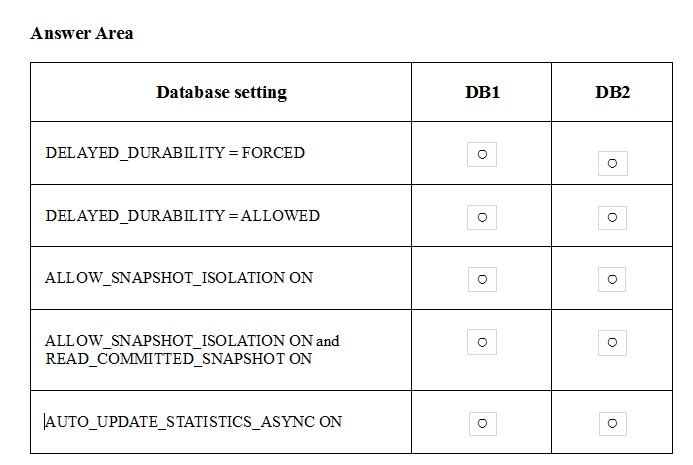

HOTSPOT -
Background -
You manage a Microsoft SQL Server environment that includes the following databases: DB1, DB2, Reporting.
The environment also includes SQL Reporting Services (SSRS) and SQL Server Analysis Services (SSAS). All SSRS and SSAS servers use named instances.
You configure a firewall rule for SSAS.
Databases -
Database Name:
DB1 -
Notes:
This database was migrated from SQL Server 2012 to SQL Server 2016. Thousands of records are inserted into DB1 or updated each second. Inserts are made by many different external applications that your company's developers do not control. You observe that transaction log write latency is a bottleneck in performance. Because of the transient nature of all the data in this database, the business can tolerate some data loss in the event of a server shutdown.
Database Name:
DB2 -
Notes:
This database was migrated from SQL Server 2012 to SQL Server 2016. Thousands of records are updated or inserted per second. You observe that the
WRITELOG wait type is the highest aggregated wait type. Most writes must have no tolerance for data loss in the event of a server shutdown. The business has identified certain write queries where data loss is tolerable in the event of a server shutdown.
Database Name:
Reporting -
Notes:
You create a SQL Server-authenticated login named BIAppUser on the SQL Server instance to support users of the Reporting database. The BIAppUser login is not a member of the sysadmin role.
You plan to configure performance-monitoring alerts for this instance by using SQL Agent Alerts.
You need to maximize performance of writes to each database without requiring changes to existing database tables.
In the table below, identify the database setting that you must configure for each database.
NOTE: Make only one selection in each column. Each correct selection is worth one point.
Hot Area:

STH
Highly Voted 5 years, 9 months agoKC
4 years, 11 months agoCodeMaestro
Most Recent 4 years, 11 months ago